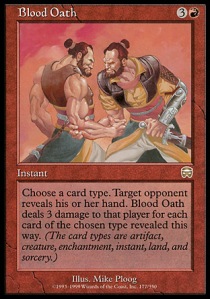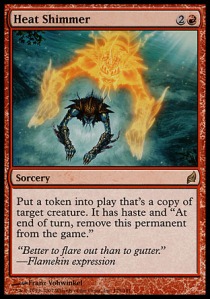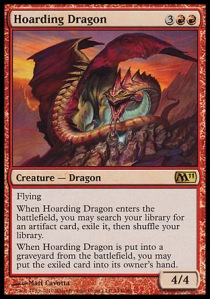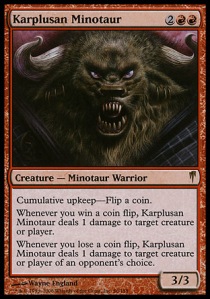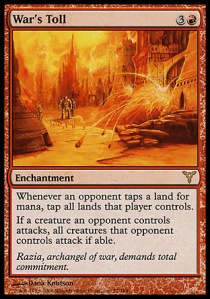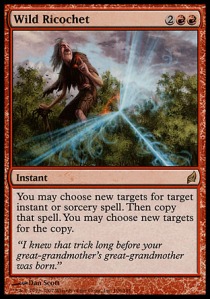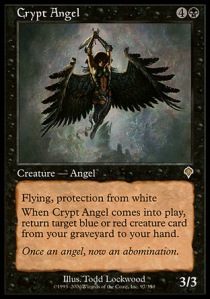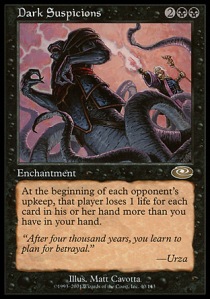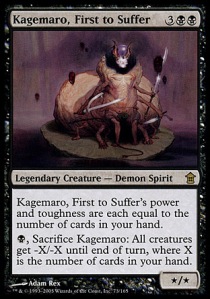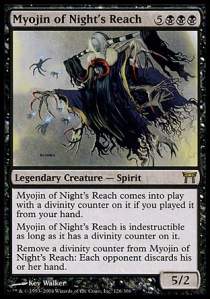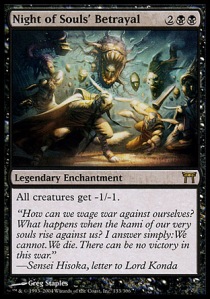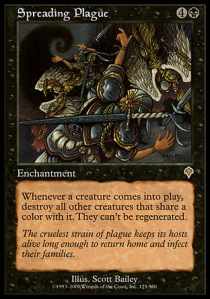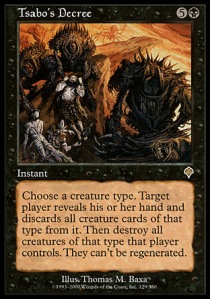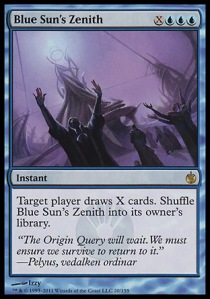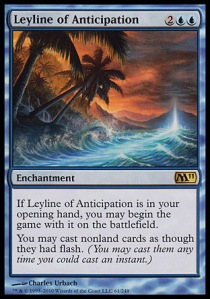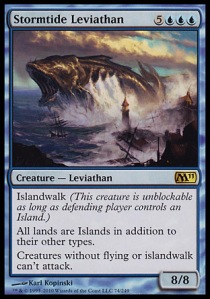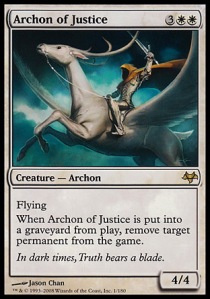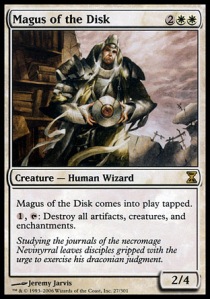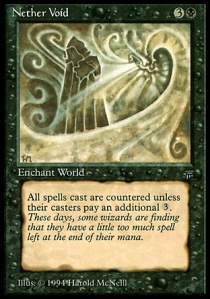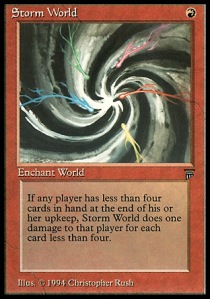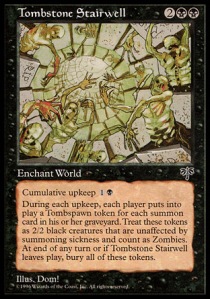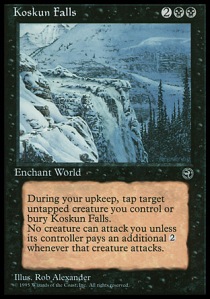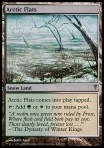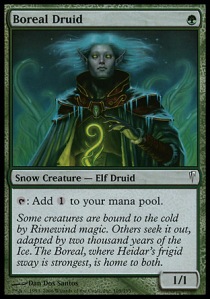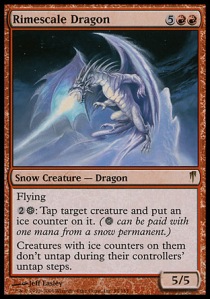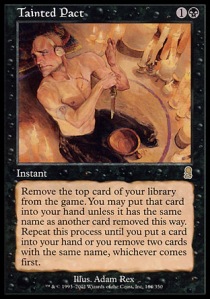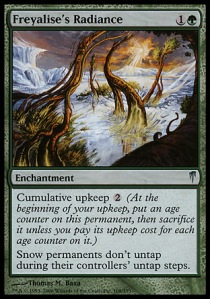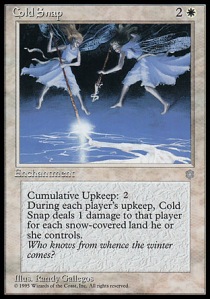Red has the dubious distinction of being considered the weakest color in Commander. Enchantments are nearly impossible for the color to handle throughout the entire history of Magic. The color has little in the way of disrupting the stack or controlling people’s hands. What Red does have to offer more than any other color is mass land destruction and “chaotic” effects. The problem is that these cards are either shunned by many play groups as anti social or aren’t conducive to winning the game. What’s a Red mage to do?
For the newcomers to this series, here’s a mission statement:
- All cards listed can be acquired for less than a dollar
- For those not on a budget, you can still find these as cheap pimp outs
- Some of these cards are on the reserved list and aren’t getting any easier to find
And here we go…
An-Zerrin Ruins
An-Zerrin Ruins has the ability to hose down tribal strategies. The other awesome thing you can do is just name the creature type of someone’s general and put it into a soft limbo. It’s been recently said that most people just don’t have enough enchantment removal and the Ruins is one of those oddball cards that can encourage your opponents to adopt more enchantment hate. There are times where this card can turn into a major griefing experience if you are using it against deck like Slivers and Elves that are traditionally more casual and thus have fewer answers to lock down enchantments.
Blood Oath
There are time when people start to drift towards drawing too many cards at once. Whether it is the Black player who always tutor for Necropotence or a guy who finds it funny to abuse Consecrated Sphinx, there are bound to be people in your playgroup who become vulnerable to blow outs from Blood Oath. It will usually be wise to name land unless you have a sick read on their hand or deck. I will say that you can combo it with some cards like Sunder, Evacuation and Soulquake. If those cards are popular in your group, then Blood Oath will work for you with the minimum amount of build around needed.
Confusion in the Ranks
I have a fondness for Confusion in the Ranks as it is one of the centerpieces of my Norin the Wary deck. The other ways to open up the potential of Confusion in the Ranks are ways to make lots of tokens. One facet of Confusion in the Ranks that people may miss is that it triggers for itself. So the turn you cast it you can snag some awesome enchantment that normally red can’t answer well. There have been multiple times where the game was looking rough for me due to a problematic enchantment only for the Confusion to save the day (Thanks for the Form of the Dragon, bro!).
Conquering Manticore
I’m a big fan of creatures with enter the battlefield effects. Often times they have an immediate impact on the game that can insulate you from the disadvantage of an opponent wiping out the board. For it’s casting cost, a 5/5 flier is pretty efficient. The real X factor here is the “Threaten” effect. In playgroups with Giant Fatties hitting the table, this can turn the tables. Even against more utilitarian playgroups, taking someones Arcanis or Terastodon can be enough to gain an edge. I won’t lie and say the Manticore is a super star, but it’s definitely in the realm of a quality fatty.
Demonfire
The higher a cards mana cost, the more desirable the words “can’t be countered” are. When you want to burn the living daylights out of someone/something, you normally don’t want it to be meddled with. While the “Hellbent” restriction is somewhat heavy, Demonfire is still amazing. While Banefire has overtaken Demonfire’s position as the go to uncounterable x spell, it’s still a pretty strong card. One of the advantages that Demonfire has over Banefire is that Demonfire can exile problematic threats to take care of it permanently.
Godo, Bandit Warlord
If I could use only one word to describe Godo, that word would be brutal. Godo is one of those rare Generals Commanders that can be competitive and “spikey” without crossing into jerk territory. A turn 2 Godo might pick up some shoes or something badass, but it’s not like he goes around killing people in a hit or two. Even the most absurd Godo lists are hardly degenerate as they interact via creature combat, the way most people envision EDH. On the flip side, I find making Godo part of your 99 interesting. I find Godo to be best in decks like WR where equipments are more than welcome. Perhaps Godo will become friends with Jor Kadeen, the Prevailer. I think that Godo needs about 5 good equipments in order to really shine as part of your 99. The bigger the better, but even solid role player’s like Loxodon Warhammer, the Swords, and Whispersilk Cloak can ensure that Godo always brings value.
Heat Shimmer
Heat Shimmer is unique for red since it doesn’t get that many copying effects. At first blush, Heat Shimmer appears to be a Threaten variant that doesn’t play as well with sacrifice effects. Much like Clone, Heat Shimmer can serve as a Hero’s Demise in a pinch by using the Legend Rule to off something. One of the problems with running a critical mass of Threaten effects is that if you want to cast two of them simultaneously, the drop off between the best and the second best target is huge and Heat Shimmer can circumvent that. It also get’s around other people not having awesome creatures since you can copy your own. Some of the better generals to use Heat Shimmer with are Brion Stoutarm, Lyzolda, the Blood Witch, and Kiki-Jiki, Mirror Breaker.
Hoarding Dragon
There are few creatures that provide a “Tutor” effect when they enter the battlefield and even fewer red creatures (you know, aside from Godo…). I’m a fan of Hoarding Dragon on many levels. It’s not just a tutor tacked onto a body, it presents a potential dilemma for your opposition. Do they expose themselves to the treasure your Dragon has hidden or try to play around your Dragon. Granted, in a multiplayer Eternal format, the dragon is not as much of a threat compared to formats where exile and “tuck” effects are less common. Overall, it’s hard to argue with a decent sized flier that can set up future plays. When used in conjunction with cards like High Market or Helm of Possession, you can protect the dragon from tampering.
Karplusan Minotaur
It’s no secret that I have an unhealthy fixation with Coldsnap (the greatest terrible set of all time, take that Homelands and Fallen Empires). Wizards just doesn’t make enough cards like Karplusan Minotaur. This card can be deceptively abusive. While alliances can be forged to handle troubling permanents (like Seedborn Muse), Lightning Greaves/Whispersilk Cloak can protect your fun times from your opposition deciding they’ve had enough. It’s important to not that the Minotaur only triggers off the coins that you flip and have you call heads or tails. The Minotaur also triggers off any flip you do, not just those that come from itself. This card is a total combo with Chance Encounter.
Keldon Firebombers
I’m a real fan of the Firebombers. It provides a way to stop the insanity of people ramping their lands and mana production out of control while not completely crippling everyone. The fact that it can pick up some choice equipment and bring the beats is a bonus. The Firebombers may not win you a lot of fans, but they can win you some games.
Magnivore
Magnivore is a cool type of midrange creature. It can easily be 10/10+ by your fifth turn depending on the types of decks you are playing again and having haste can lead to some quick beats. If you use cards like Wheel of Fortune and Windfall, you can really amp up the beats. The other approach to amp up your graveyard quickly is to go with a critical mass of sorceries like Ponder and Preordain that replace themselves so you can string them together. I have been using Magnivore in my developmental builds of some Blue/Red decks and have been quite satisfied.
Mindmoil
I like to compare Mindmoil to a personal Teferi’s Puzzle Box. Red doesn’t have much in the way of deck manipulation so having the ability to filter through multiple hands can be extremely useful. The most obvious combo potential is with effects such as Niv-Mizzet, the Firemind or Psychosis Crawler. Mindmoil has some awesome interactions with buyback and flashback spells as you get to cycle through more of your deck.
Obliterate
I had a slight impulse to not add Obliterate to this list. Not that I disagree with it on a fundamental basis (I’m all for turning the table into a durdling mess), but because it’s pretty well known. However, the fact that so many people avoid such a powerful card must be due to a knowledge gap and not something else (Right? Right?). There is not subtly to it. You play this card when you want to blow up the world (barring enchantments and Planeswalkers). There are ways around it, but not many of those answers see play (Second Sunrise, Mindbreak Trap, Time Stop) so your Obliterate will normally resolve. In my decks that use obliterate, I am normally packing lots of indestructible cards like Darksteel Ingot, Darksteel Myr and Stuffy Doll. It figures that the same decks that would want to blow up the world would also want lots of sturdy defenders (from all the vindictive people coming after you). Obliterate will not make you popular and will expose you as a griefer. That’s fine. You are going to win or at the very least stop losing (short term).
Ruination
There comes a point in a Commander player’s developmental cycle where their decks will become stuffed with nonbasic lands. It’s an understandable phenomenon. Who wants to draw a bunch of blank basic lands? The problem is that it’s a well known fact that basic lands are less vulnerable to most hate unless people are tying to Boil people out of the game, wreck them with a Tsunami, bring the Acid Rain, or other mass LD based hosers. Ruination is one of those cards that teaches people the value of basics. Compared to more expensive options like Blood Moon, Magus of the Moon, and Back to Basics, Ruination provides a one shot effect that can curtail the mana production potential of your opposition for the rest of the game with limited potential to recover compared to top decking a Disenchant effect. Much like other mass land destruction, don’t bring these into a Commander game unless you are willing to cripple people.
Thieves Auction
A few years back, a friend on Efnet introduced me to his Norin the Wary deck. This was before the word was remotely out on Red decks being not automatically trash and Norin having some potential. I looked at his deck list and noticed it was a bunch of artifact mana, goofy cards, and board sweepers. How could that possibly win? The answer was that no one ever expects half of this crap and half the people you will play against will be confused by some of the crazy cards in the deck. This was one that stuck out to me. I thought that this card would never be amazing. I was wrong. When the best card you have in the pot is typically Thran Dynamo, then your nearly always a winner. Being able to go first pretty much ensures you get the Blightsteel Colossus or Ulamog, the Infinite Gyre that’s terrorizing the table and you can try to steer the game more to your liking. The really funny part is that most people don’t rage quit against this card (barring the rare scoop in response) or even complain too much about it. Sure it foiled their plans and turned the game into a mes, but people generally feel its within the “spirit” of the format.
Thundermare
I’m a fan of the flaming horse. Thundermare enables an unimpeded strike at the cost losing your own defenses. In multiplayer games it has the cascading effect of leaving the people who have the turn before yours vulnerable to more strikes as well. Some people look at Thundermare and think it will be impractical as anything but a finishing blow, but I see other potential there. When you combine it with permanents that turn into creatures, you can enable much larger strikes. As Red doesn’t have many ways to tap a lot of creatures simultaneously, Thundermare can fit that niche while providing a large body. I hear that tapping down mass amount of creatures leads to snyergy with Smoke. Yeah, Smoke! If you are wanting to build around effects like smoke, you can find redundancy with Shrieking Mogg.
War’s Toll
There is a growing subset of Commander players who are embracing Group Hate decks. Jam packed full of cards like Manabarbs and Zo-Zu the Punisher, the goal of these deck is to put a hamper on people’s strategies while also putting them in enough out of their comfort zone to encourage the opposition to make mistakes. I actually consider War’s Toll as one of these cards. It works really well with Manabarbs by forcing your opponent to choose between massive amounts of damage or not doing anything. Furthermore, War’s Toll can really put a hamper on things like your opponent’s Rhystic Study or EOT Sensei’s Divining Top. Why? Because your opponent’s will have to spend most of their mana at a single time. That’s right, War’s Toll can actually make your opponents better at Magic! Outside of that, War’s Toll really has some synergy with taxation effects like Propaganda and Rhystic Deluge. Propaganda is doubly nice as it means they can’t cast anything but instants (usually) that turn and they will have little defense as even if they can’t swing at you with everything, they can probably swing at someone with the rest of it. As a fair warning, there are some people who are very hostile towards War’s Toll and may decide that killing you as fast as possible is the best idea. If you want another way to hamper your opposition’s mana production you can try Mana Web.
Wild Research
One of the biggest limiting factors of Wild Research is that it can only be used in Numot, the Devastator decks. The other drawback is that for every card you tutor up, you have to discard a card. You can get around that drawback that by using effects like Library of Leng or Bösium Strip. Another potential plan is to fill up your graveyard with enchantments so you can unleash a huge Replenish on your opponents. While they are not many, cards with Madness can work around the discard. It’s definitely a card that requires some set up and synergy, but I find it to be quite worth it.
Wild Ricochet
I see Wild Ricochet and it’s brethren as Red’s ability to interact with the stack. This ability to cause mischief and mayhem on the stack is a crucial part of Red’s identity as without embracing it, your mono red decks can end up pretty flat. Of all the effects that fit into this category, Wild Ricochet has the splashiest and biggest effect without forcing the game into complete chaos. The first time you get to cast Wild Ricochet targeting Identity Crisis or Cruel Ultimatum or similar giant spell, you will never want to put down the Wild Ricochet. While some people may complain about the effect this card can have on games, sometimes you just gotta respond with, “Live by the sword, die by the sword.”
Word of Seizing
There are some times where making sure people don’t mess with your plans is crucial and I think borrowing an awesome permanent is one of those. It’s a personal rule of mine that if I have the option to take and active someones Mindslaver, I have to. Seriously… Plop it and pop it people; Mindslaver shouldn’t be waiting around. Even outside of split second and hitting any permanent, the Word is notable for another reason. The majority of Red’s instant speed temporary stealing cards are sorcery speed. You can have all the Threaten variants you want but the instant speed versions (aka Ray of Command spin offs) are typically riddled with drawbacks. Temporary Insanity is reliant upon the graveyard in a world that is increasingly hostile towards graveyard. Blind with Anger can’t hit Legends, who are typically the biggest and baddest at many commander tables. These effects are normally best for surprise blocks, surprise kills with another player’s commander, or just stealing a cool ability like Magus of the Jar.
Bonus Section
Rather than just hoard this tech, I am going to list some of the cards that overlapped with some the cards on the list and just barely missed the list. Most of the strategy applications are similar to other cards on the list. This seems to be my definitive proof that not only red not terrible, but a lot of it’s high points are budget friendly.
Nonbasic Land Hate
Mass Land Destruction
- Boom/Bust
- Epicenter
- Impending Disaster
- Omen of Fire
- Tectonic Break
- Thoughts of Ruin
- Wake of Destruction
Board Control
Stack Manipulation
Chaos/Harassment Effects
- Burning Sands
- Goblin Game
- Grip of Chaos
- Illicit Auction
- Leyline of Punishment
- Mages’ Contest
- Manabarbs
- Smoke
- Tunnel Ignus
- Twist Allegiance
- Warp World
Fan Service for the Ib Halfheart, Goblin Tactician Nation
X-Spells
Cheap Dragons
- Ancient Hellkite
- Flameblast Dragon
- Furnace Dragon
- Hellkite Charger
- Hoard-Smelter Dragon
- Hunted Dragon
- Knollspine Dragon
- Mordant Dragon
- Scourge of Kher Ridges
- Shivan Dragon
- Shivan Hellkite
- Voracious Dragon
Cheap Legends
- Ashling the Pilgrim
- Fumiko the Lowblood
- Heartless Hidetsugu
- Ib Halfheart, Goblin Tactician
- Jaya Ballard, Task Mage
- Kazuul, Tyrant of the Cliffs
- Kumano, Master Yamabushi
- Norin the Wary
- Patron of the Akki
- Zo-Zu the Punisher
So that’s a wrap on the wonderful world of Red. I hope that this article has opened up a desire in some of you to rock the red decks. Up next is Green the color of the fatty…

